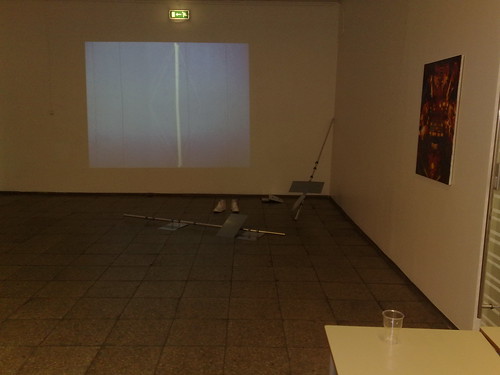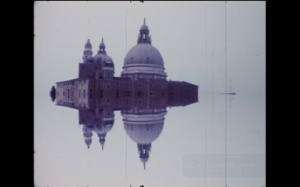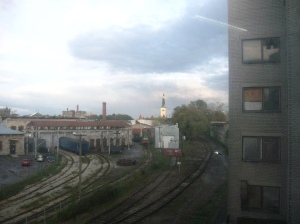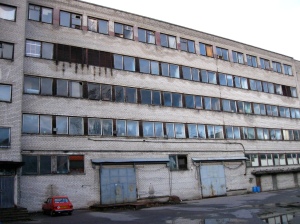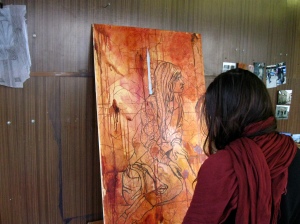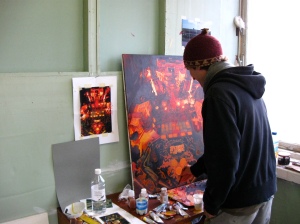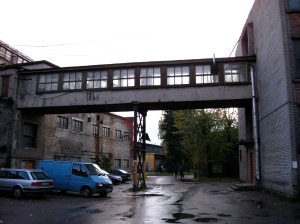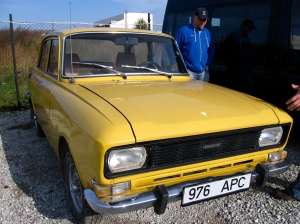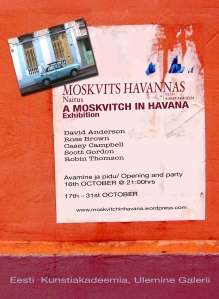Well, it’s not a bad question, as there seems little or no connection between five young Scottish artists exhibiting in the capital of Estonia, and an old Soviet car in the capital of Cuba.
Exhibition titles, and, increasingly, gallery names, often appear to be either meaningless or designed simply to confuse the visitor. Take, for example, the series of exhibitions called Novi Fragmenti in Zagreb, Croatia, or the artists’ collective Limousine Bull in Aberdeen, Scotland. These names have their own significance to those who came up with it. But, to anyone not privy to the decision-making process, they are meaningless- a brand name rather than a descriptor.
“A Moskvitch in Havana” is not a brand name, but more a metaphorical title attempting to provoke curiosity. Twenty years ago, in Soviet Estonia, the Moskvitch car was pretty ubiquitous. Now, the factory that made it lies in ruins in Moscow and its products are little more than industrial junk, slowly fading into history. Occasionally one will still be seen on the road, driven by an elderly person, or plastered with mock racing-car adverts, and raced by younger drivers for whom the car is not a necessity, but a disposable weekend pleasure. Why Havana? Because the Cuban capital is one of the last places on earth where a version of the Soviet system still exercises political power. It is bizarre enough that the ideology of “Marxism-Leninism”, with its roots in late nineteenth century and early twentieth century European idealism, should be transposed onto a Caribbean island; that some of the material products of that ideology should still be in use there is even more of an unexpected juxtaposition. The exhibition title, therefore, arises from the feeling that all these artists have in being transplanted from one specific cultural background to another, attempting, through a focus on urban transformation, to negotiate that difference, and to communicate within it.
It is also no co-incidence that the artists taking part in the show are interested, in different ways, in “dead” city zones and the effect that the transformation from one mode of living to another has on the individual. Tourist Tallinn has already been “transformed” into a mediaevel fun palace, with the only sign of the recent Soviet past to be found in some 1970s memorial plaques and on T-shirts. Moving beyond the Old Town into “Real Tallinn”, and there are far more indicators in terms of decaying industrial buildings and empty “brownfield” land awaiting a new use.
One such space, an old toy factory on Madara tn., has already been transformed into a set of studios and exhibition spaces, at the centre of which is the Non Grata Kunstikonteiner; just around the city centre many more such spaces await re-branding or demolition.
As when Tallinn “modernised” and was electrified in the 1920s, during the early years of the first Estonian republic, the frantic pace of change in the city since the collpase of the USSR, from provincial, small industrial outpost, to European capital city, has left many behind and struggling to process the magnitude of the changes, in the last ten years. In some senses these disused industrial buildings function as a symbol of those whose mental map of Tallinn was drawn in the Soviet past, and who feel slightly ill at ease in the ever changing present.
Buildings also function as an unnoticed backdrop to people’s mundane, everyday routines. These artists all have an interest in city spaces that are not really noticed by the people that use them. They also have an interest in empty urban space: wastelands at a point of transformation, from a historical use in a fast receding past, to a future function defined only in an architect’s drawing and seen by city planners.
This exhibition, in painting, three dimensional art, photography, and graffiti, has those moments of transformation at its core. In the next few entries, the participating artists will be introduced in more detail as we count down to the opening night.
